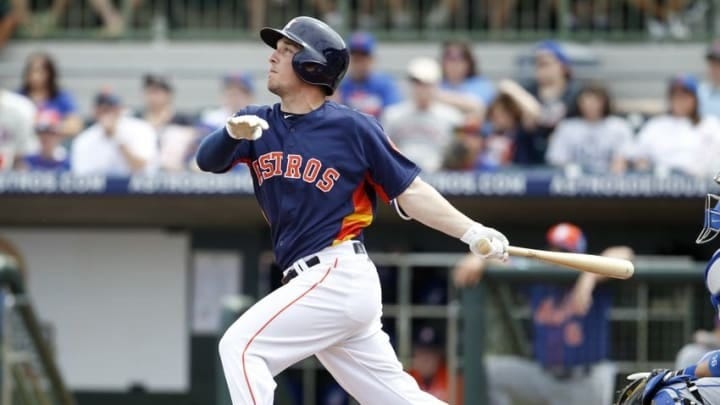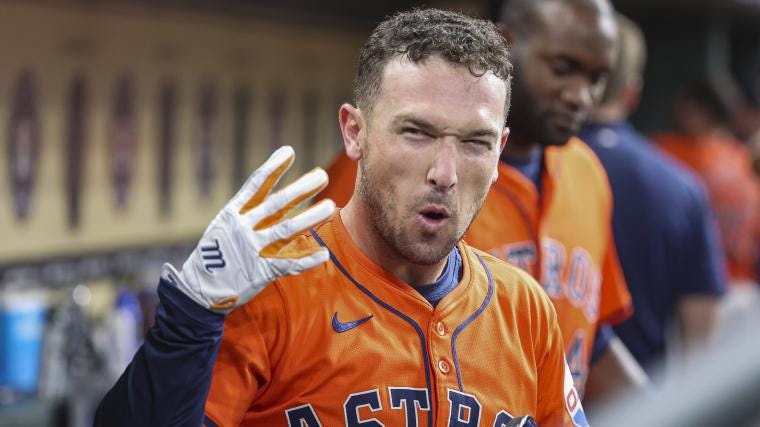This is post No.2 on this blog, which is your guide to the 2025 baseball season, which starts on March 18 and then stops, and then starts for real on March 27. This one explains the two most common types of player moves in MLB. If you like this stuff, you should DEFINITELY subscribe.
Today (Thursday, February 13) news broke that Alex Bregman has agreed to join the Boston Red Sox. And so concluded the most tantalising part of baseball’s off-season player movement: the free agent sweepstakes.
Nearer the start of the feeding frenzy, Kyle Tucker joined the Chicago Cubs in one of the winter’s biggest trades.
These are the two most common ways for players to move teams, and it just so happens that until this winter, Bregman and Tucker were teammates on a Houston Astros team that they powered to the 2022 World Series title (Bregman was also part of the 2017 win, but that one’s complicated and we’ll talk about it some other time).
So they’re a perfect pair through which to tell the story of how players move in baseball. As Fabrizio Romano, the Michael Buffer of football transfers, might say: HERE WE GO!
Part One: Pay dat man heeeez money!
To become a free agent in baseball is to survive a test of skill, endurance and good fortune akin to Jean-Claude Van Damme’s victory in the kumite in the 1988 comedy-drama Bloodsport. It’s hard. Like Van Damme’s abs in Bloodsport.
Alex Bregman was selected with the second pick in the 2015 MLB draft by Houston. He was expected to become an MLB player and that’s exactly what happened, in double-quick time. By July 2016 he had broke the hearts of enough minor league pitchers to earn a call up to the big leagues. He was 22 years old and his service time clock was ticking.
Once a player reaches MLB level, they accrue service time. Clock up six years and you enter the free agent market, where clubs compete for the best players by offering long-term contracts that often go into nine figures.
For the first three years, players earn ‘league minimum,’ a salary negotiated between the league and the players’ union. In 2016, that was $500,000 for a full year of MLB service, but Bregman only played 49 of the 162 games. He would have been paid pro rata and 2016 did not count as one of his full years of service.
By early 2019 he was Houston’s starting third baseman, an elite defender in that position, and one of the most reliable bats in the game. Houston still had Bregman on the league minimum for one more season, before he would move to three years of arbitration (2020-22 inclusive), a period where a player’s salary increases according to time served and on-field performance metrics. Each winter, if club and player cannot agree on a salary, one is set for them by an independent arbitrator.
For the majority of players who make it to MLB level - never mind the many, many more who never escape the minor leagues - accruing six years of service is a mountain they can never climb. Not the case for Alex Bregman.
Houston had become a juggernaut team with long-term plans for success and before the 2019 season they decided to offer Bregman a contract that would buy him out of those four remaining years of control, and keep him for an additional two years, until the end of the 2024 season. They guaranteed Bregman $100m over those six years and the then 24-year-old agreed to push back his free agency for the kind of security and inner peace that comes with all that money.
Which brings us up to date. Just before Christmas 2024, deals started to drop for this year’s most-wanted free agents - most noticeably Juan Soto, who had powered the New York Yankees to the American League championship and moved across town to the Mets on a contract worth… and I’m not kidding around here… $800m.
By this week, only Bregman remained from the premier free agents who had entered the market at the start of the winter.
As players reported for spring training, four teams still had plans to break the bank for Bregman: Houston, the Detroit Tigers, the Chicago Cubs and the Boston Red Sox. Detroit offered him the biggest contract - $171.5m over six years - but he chose to join Boston on a three-year contract, during which he will make $40m in each of those seasons. He also has the option to opt-out after each of the first two, should his market value increase. In annual salary terms, it’s one of the biggest deals in baseball.
And it’s the prize for making it this far; for grinding through the minor leagues; for clocking up six years of 162-game regular seasons; for being a two-time world champion; a three-time winner of the Golden Glove (awarded to the best player in each position in each league). You do that, you get all the chips, just like Matt Damon in Rounders. In the immortal words of Teddy KGB: Pay dat man heeeez money.





